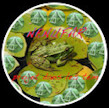|
Home The project NenuFAR – the LOFAR Super Station in Nançay – is a major extension of the LOFAR array, that will dramatically increase its total sensitivity and resolution and allow astronomers to address such fundamental scientific questions as : (i) What is the nature of the processes that couple the stellar winds to the planetary systems? (this applies to our solar system as well as to exoplanets) (ii) What is the spatial structure and dynamics of the interstellar warm plasma in the Milky way? (iii) What are the populations and physical processes underlying the unveiled Impulsional Universe? (iv) What were the physical processes controlling the evolution of the baryonic matter at very high redshift (z>10) ? And (v) How did the Universe take its local shape over cosmic time scales ? The concept of a LOFAR super station “NenuFAR” is described in [1]. NenuFAR consists of adding to the standard Nançay LOFAR station (FR606) 96 low frequency tiles, that will be connected to the LOFAR backend. Each tile is an regular hexagonal cluster – or “mini-array” (MA) of 19 crossed-dipole antennas, analogically phased. The 96 MA will be distributed in a disk of ~400 m in diameter (~6 LOFAR station diameters). The frequency range of operation will include the LOFAR-Low Band (LBA) 30-80 MHz and extend it mostly to lower frequencies (i.e. to the range ~10-85 MHz). NenuFAR will be both a high-sensitivity LOFAR-compatible “super-LBA station” and, owing to its dedicated receiver, a large sensitive standalone instrument(a “low frequency Arecibo” in Nançay). A preliminary description of the observation modes offered by NenuFAR is given in [1,2]. In summary, NenuFAR will be used either as part of the LOFAR network as a super-sensitive LBA station improving LOFAR’s global sensitivity and imaging capabilities, or as a standalone instrument with large instantaneous sensitivity (~2x LOFAR’s core) rather oriented toward coherent phased-array observations, especially toward low frequencies. A dedicated receiver will allow NenuFAR to be used simultaneously in both modes, within the instantaneous FoV of the MA. The science objectives of NenuFAR – also briefly listed in [1,2] – include searches and studies of (1) exoplanets and binary or eruptive stars, (2) pulsars and Rotating RAdio Transients (RRATs), (3) the structure of the Galactic Interstellar Medium (ISM), (4) galaxy formation and pre-EoR dark ages cosmological signal, (5) the “impulsional” Universe, (6) Transient Luminous Events (TLE) in the Earth and planetary atmospheres, and (7) Solar system physics. A design study conducted from 10/2009 to 2/2013 permitted to define and test all the elements of NenuFAR’s design, and to evaluate the cost of the project. All technical studies and reports are available here. Facing the difficulty to obtain the guarantee of a recurrent funding, the project was reconfigured to be built in a modular way (successive fundings being used to build additional MA), starting with a « Phase 1 » corresponding to the size required for a significant scientific impact. This phase 1 is now planned for 22 MA, plus the 3 prototype ones. Taking into account of a 20% security margin, standard for such big projects, phase 1 will include 20 to 25 MA of 19 dual-polarized antennas each, and the corresponding electronics, as well the preparation of infrastructures for the whole project. NenuFAR-1 is described in [3] (with its initial size, estimated to 15 MA). Its construction started last november. With (20 à 25)x19 = 380 to 475 crossed dipole antennas, NenuFAR-1 will have capabilities significantly superior (1.7-1.8x) to the LOFAR Superterp [4] or the american LWA (Long Wavelength Array) in New Mexico, but retaining full expandability of NenuFAR-1 into NenuFAR. The french community will be a privileged user of NenuFAR, who will play the role of a scientific precursor of SKA, supported by the “SKA-LOFAR specific action”. The objective of this workshop is to present the instrument in detail, define relevant phases from NenuFAR-1 to the full NenuFAR, strengthen their science case, and gather and involve a growing community in the construction, test and exploitation of the instrument. A major objective is to prepare a finalized, collective, and modular (phase-by-phase) Science Case in view of the CNRS/INSU prospective of fall 2014. We encourage you to download and read documents [2,3,5] in preparation of this collective effort. Interested people are encouraged to register ASAP on the web site here, and submit oral (or poster) contributions. As the workshop is in direct continuation of the SKA-LOFAR radio days, some scientific material may have been covered by the « journées… » and simply be summarized during the workshop. As for the « journées… » there will be no registration fee. Practical information (Venue, Hotels & Restaurants …) can be found on the site of the « jounées … ». For more information, contact : nenufar@sciencesconf.org. [3] NenuFAR-1_Science-Case-2013-v1.2.pdf
|
| Online user: 1 | eRSS Feed |

|

